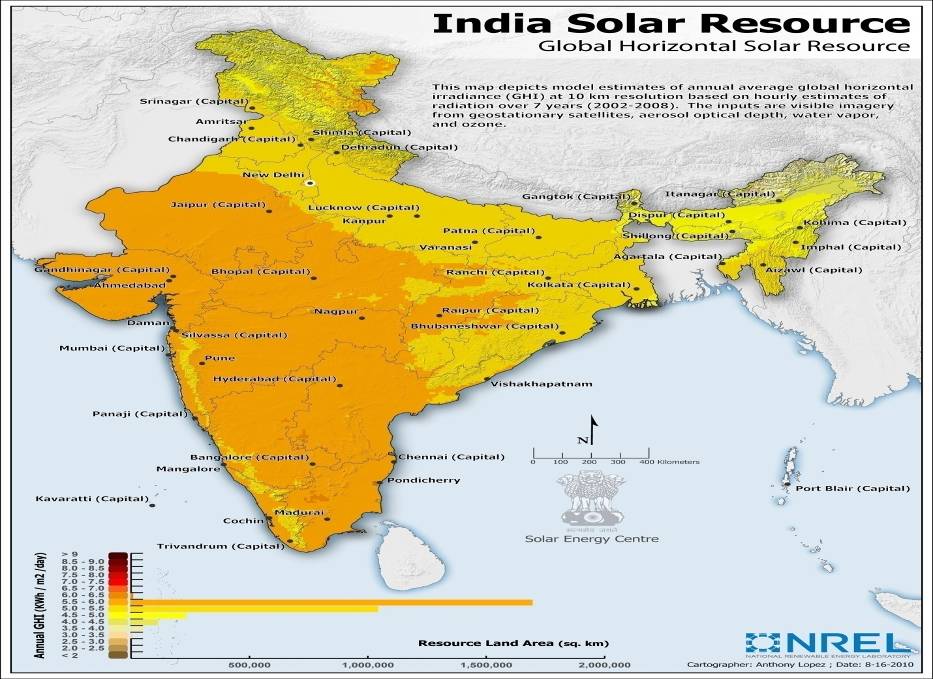Solar Radiation Data For India Is Depicted In The Map Below

India is densely populated and has high solar insolation, an ideal combination for using solar power in India. Moreover, it’s other energy resources are relatively scarce. In the solar energy sector, some large projects have been proposed, and a 35,000 km2 (14,000 sq mi) area of the Thar Desert has been set aside for solar power projects, sufficient to generate 700 to 2,100 GW.
In July 2009, India unveiled a US$19 billion plan to produce 20 GW of solar power by 2020.Under the plan, the use of solar-powered equipment and applications would be made compulsory in all government buildings, as well as hospitals and hotels. In January 2015, the Indian government significantly expanded its solar plans, targeting US$100 billion of investment and 100 GW of solar capacity by 2022.
According to a 2011 report by BRIDGE TO INDIA and GTM Research, India is facing a perfect storm of factors that will drive solar photovoltaic (PV) adoption at a “furious pace over the next five years and beyond”. The falling prices of PV panels, mostly from China but also from the U.S., have coincided with the growing cost of grid power in India. Government support and ample solar resources have also helped to increase solar adoption, but perhaps the biggest factor has been need. India, “as a growing economy with a surging middle class, is now facing a severe electricity deficit that often runs between 10% and 13% of daily need”. India is planning to install the World’s largest Solar Power Plant with 4,000 MW Capacity near Sambhar Lake in Rajasthan.
There are various factors that we need to consider before investing into a solar power plant. A lot of enthusiasm has been seen among people about the use of Solar Energy as a substitute of conventional sources of energy. However, currently, with the power subsidies in India, solar works economical only in those areas that are using diesel generators as a primary source of electricity. The entire payback is made in 2–3 years. Solar system for petrol pumps is a leading example of such an application. IOCL is leading the race for solarization of petrol pumps with aggressive targets. Solar applications for petrol pumps by RelyOn Solar has been installed in more than 150 IOCL petrol pumps across India and now other oil companies are also looking to solarize their ROs. Solar installations for commercial buildings, where the electricity rates are higher, are also proving to be a game changer for the owners of IT companies.
On 16 May 2011, India’s first 5 MW of installed capacity solar power project was registered under the Clean Development Mechanism. The project is in Sivagangai Village, Sivaganga district, Tamil Nadu.
Solar Energy Corporation Of India
The Jawaharlal Nehru National Solar Mission was launched on the 11th January, 2010 by our former Prime Minister, Dr. Manmohan Singh. The Mission has set the ambitious target of deploying 20,000 MW of grid connected solar power by 2022 and aims at reducing the cost of solar power generation in the country through long term policy, large scale deployment goals, aggressive R&D and domestic production of critical raw materials, components and products. It has been envisaged to achieve grid tariff parity by 2022.
The objective of the Jawaharlal Nehru National Solar Mission is to establish India as a global leader in solar energy, by creating the policy conditions for its large scale diffusion across the country as quickly as possible. For this purpose, the Mission has adopted a 3-phase approach: the 11th Plan and first year of the 12th Plan (up to 2012-13) has been considered as Phase 1, the remaining 4 years of the 12th Plan (2013-17) are included as Phase 2, and the 13th Plan period (2017-22) is envisaged as Phase 3. An evaluation of progress, review of capacity and targets for subsequent phases, based on emerging cost and technology trends, both domestic and global, would be undertaken at the end of each plan period, and mid-term during the 12th and 13th Plans.
The first phase of NSM focused on capturing the low hanging options in solar: on promoting off-grid systems to serve rural populations and a modest capacity addition in grid-based systems. This was partly envisaged as a learning experience for the further, ambitious goals. Now, in the second phase, an aggressive capacity ramp-up is targeted. The aim is to create favourable conditions for up-scaled and competitive solar energy penetration in both at the centralized and decentralized levels. The targets are given below:


